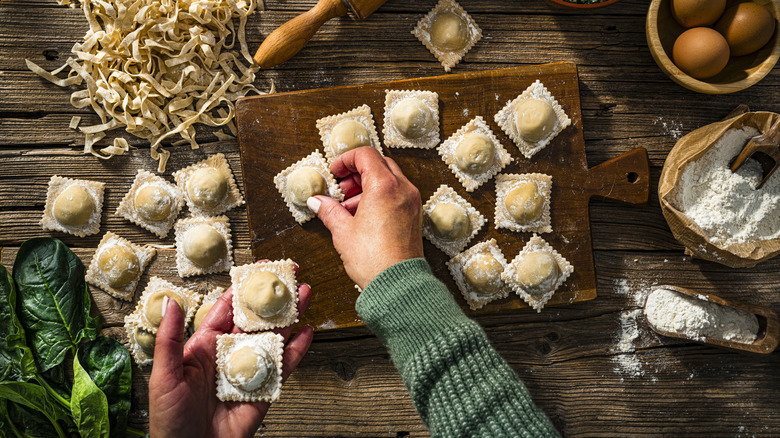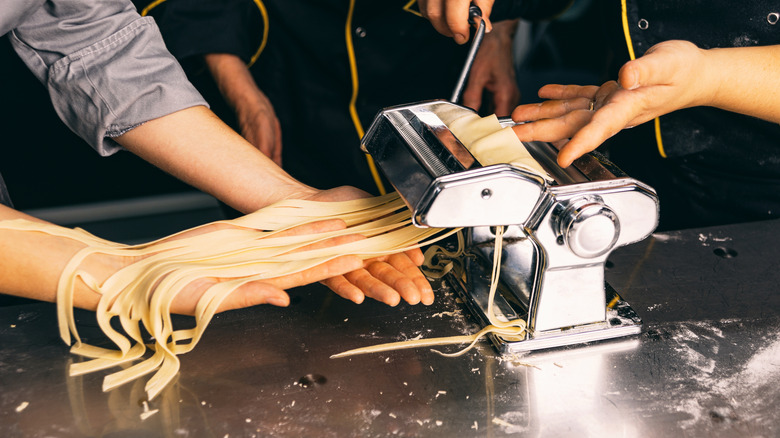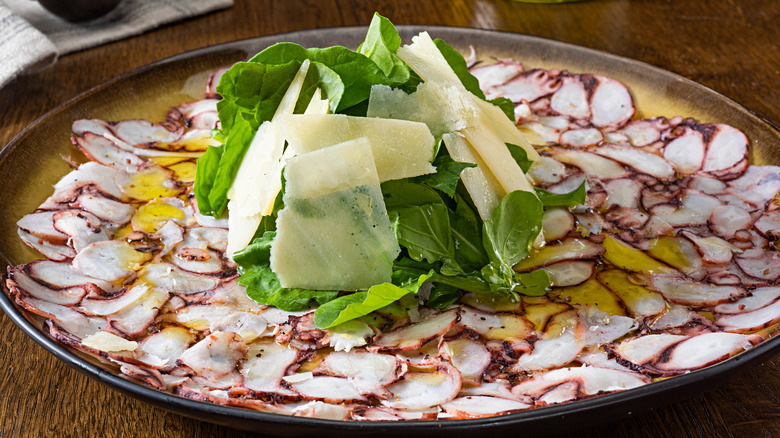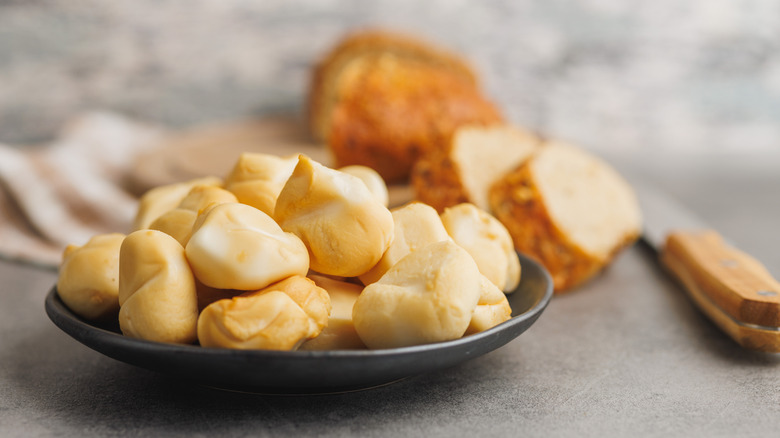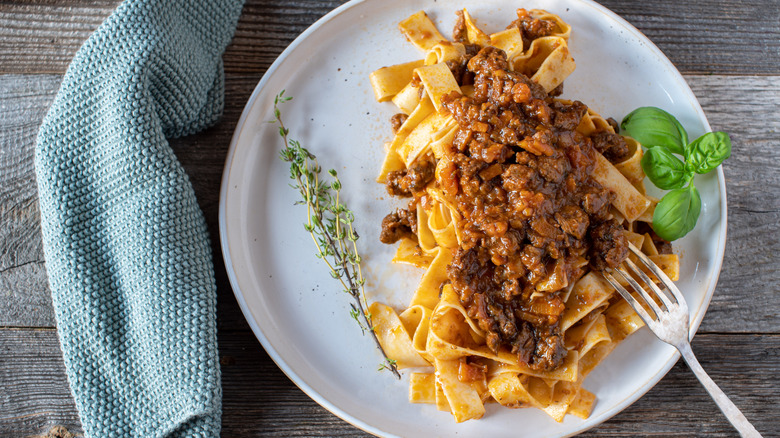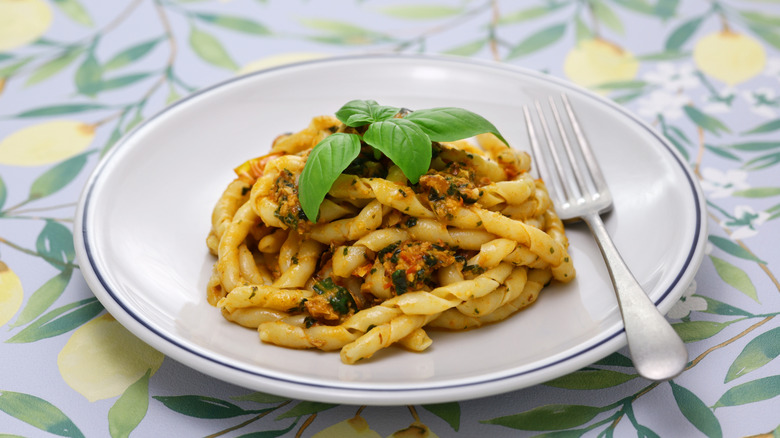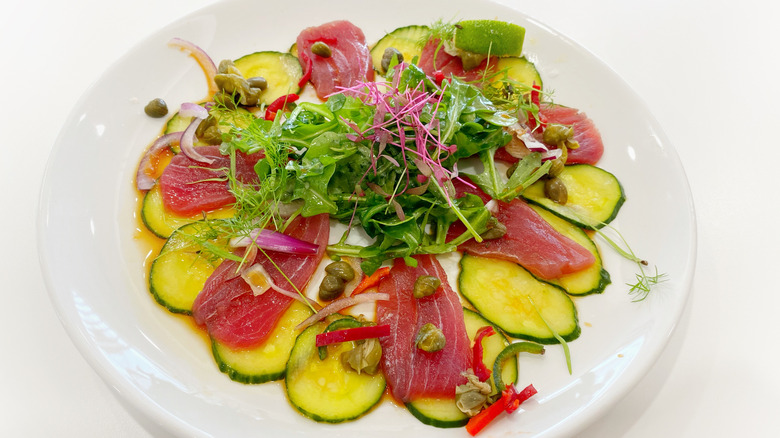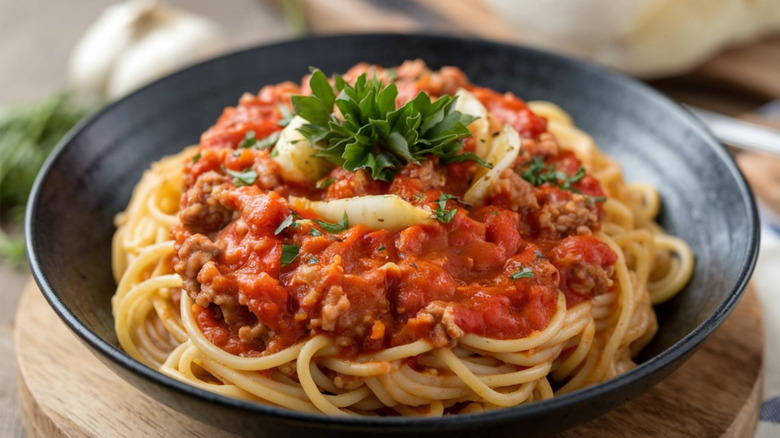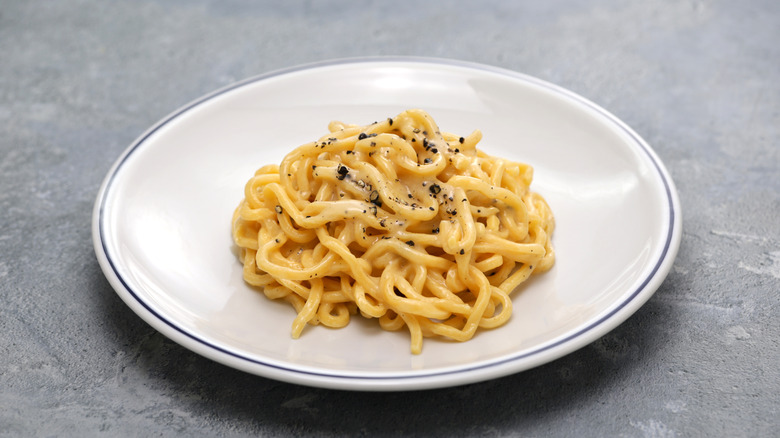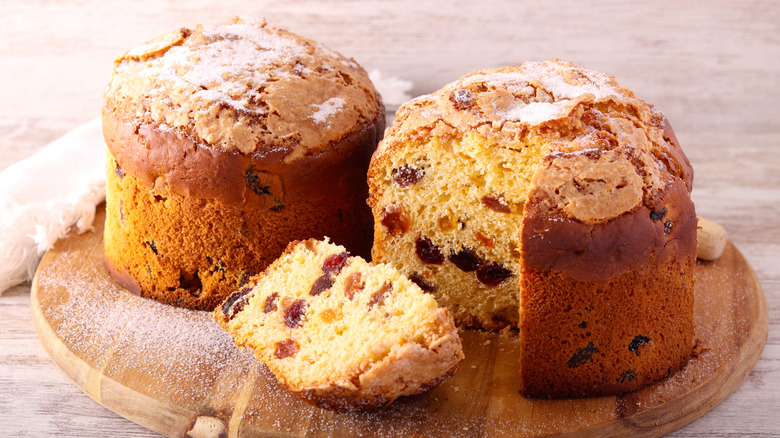10 Complicated Italian Dishes Not Worth Making At Home, According To Chefs
For the average home cook, making Italian on a weeknight might include boiling a pot of water with salt, tossing in some boxed spaghetti, and then smothering the cooked pasta in a jar of marinara. That kind of meal definitely does have its appeal, food snob or no; the meal's simplicity, convenience, budget-friendliness, and, for some, nostalgia factor, all work in its favor. However, if we're talking authentic Italian cuisine, a box of Barilla and a jar of Prego are a long way off.
Luckily, if you have more time on your hands, plus a little patience, there are plenty of traditional Italian dishes you can make at home. A nice lasagna recipe is something every home cook should have in their repertoire, alongside a great from-scratch meatball. Even if you want to get fancy, risotto is probably a lot simpler and more accessible to home cooks than you might think, if you've never made it before.
That said, not every single authentic Italian dish is going to be accessible for the average home cook. We spoke with a handful of chefs who know their way around Italian cuisine to get the inside info on the most complicated Italian dishes that aren't worth making at home, whether due to difficulty, amount of ingredients required, cost for ingredients, or any other issue. Here's what they had to say.
Homemade pasta
Maybe you're an ambitious home cook who's always eyeing up the latest and greatest countertop appliances or kitchen gadgets. Maybe your cabinets and countertops are filled with everything from an Instapot and air fryer to a food processor and fondue pot. If this sounds like you, then you've probably considered investing in a pasta maker, or at least a pasta roller attachment for your stand mixer, to try to learn to make your own pasta. While making homemade pasta is certainly impressive, though, is it really worth your time?
According to executive chef Christian Farrar of Table 20 in Cartersville, Georgia, the answer is "no." Farrar said, "These days, we're lucky to have access to some excellent dried pastas. Unless you're making ravioli or another filled pasta, it usually isn't worth the effort to try to crank out your own spaghetti or rigatoni. High-quality dried options are affordable, consistent, and easy to find."
Farrar does admit that making your own pasta from scratch can be rewarding, but you may not get much more than bragging rights from your attempt. Your end result dish may not be all that much improved from making your noodles from scratch versus buying dried pasta. "What really matters is choosing the right pasta," he said. "Look for bronze die cut styles. You want the pasta to have texture when you rub your fingers across it, and it should feel firm — the harder to break the better!"
Carpaccio
Carpaccio is a dish made of a thinly sliced, beautifully arranged protein (sometimes raw, sometimes cooked), served with a lemon-based dressing. The story goes that carpaccio was invented in Venice, at Harry's Bar — the same venue we have to thank for the bellini — in the mid-1900s. The dish, named after artist Vittorio Carpaccio, shows a splash of red and yellow reminiscent of a painting.
Now, there are many versions of carpaccio, incorporating a range of ingredients. However, if you have your heart set on giving carpaccio a try for your next cocktail party, Hector Peniche, head chef and founder of Hector's Bistro, in Mazatlán, Mexico, says you should specifically avoid attempting the classic octopus variant. "This authentic Italian aperitif is not too complicated, but it requires a certain knowledge level to cook the octopus and quality equipment to slice it perfectly," he noted.
The process certainly doesn't sound all too easy for the squeamish. Some recipes instruct you to hold an octopus by the head, dip its tentacles in boiling water until curled, and then let the entire octopus cook for up to an hour and a half. Then, you have to cut and layer the octopus in a plastic bottle, compressing the octopus down to squeeze out the liquid, before resting in the fridge for a day. The bottle molds the octopus while chilling, making for easier slicing, but you still need a ham slicer or similar to achieve slices around 1 to 4 millimeters in thickness.
Scamorza ravioli
Scamorza ravioli isn't your average filled pasta. This ravioli earns its special place thanks in part to the use of scamorza cheese. Similar to mozzarella, scamorza is drier and firmer – but unlike mozzarella, you're not going to be able to just find scamorza at your big-box grocery store. So, your first task in the long process of making scamorza ravioli will be hunting down the necessary cheese.
Then, you're going to need to undergo the laborious process of making your ravioli from scratch, as well as your pasta sauce from scratch. "Making it at home requires a pasta machine, as well as a lot of time and space to achieve a silky and soft ravioli," chef Hector Peniche told us. "The tomato sauce itself requires a few hours on the stove." All in all, this is going to be an all-day affair.
Plus, beyond the pasta machine, making ravioli requires other gadgets as well, which you might not want to invest in, if this is a one-time project for you. You'll also need a ravioli cutter – stand-ins can include cookie cutters and shot glasses, but they aren't ideal for that classic ravioli shape. Maybe just stick with a trusty can opener and give Chef Boyardee another go? There are plenty of reasons why it's remained a favorite struggle meal that is actually delicious.
Braised duck tagliatelle
Slow-cooked duck with pasta ribbons is delicious — but it's best to leave making it to the pros. "This is a great dish to serve now in autumn, as the [duck-]hunting season is usually in September and October," said Hector Peniche "However, even if you buy the duck yourself, it will take a few hours in the oven to make the meat tender enough to fall off the bone. Our signature braising liquid is also a stock that takes at least five hours to make," said the chef, wisely adding, "We must remember that time is an ingredient that can rarely be substituted."
While duck might not be the first protein you think of when considering Italian cuisine, it actually can be found in a range of traditional Italian dishes. The Romans took a liking to ducks in ancient times, discovering a fondness for both duck livers and duck leg, and that pretty much cemented duck's role in Italy. However, possibly one of Italy's most famous duck dishes is duck ragu, served with pappardelle or tagliatelle, with many recipes echoing Peniche's sentiments that preparing duck in the Italian fashion can be a time-consuming process. For example, you might need to cure the duck overnight, before searing the duck and letting it simmer — and that's on top of making homemade pasta.
Busiate
You're likely not going to find this pasta shape on the shelf next to the macaroni. A lesser-known pasta shape, busiate originated in Trapani, Sicily, as early as the 900s. Crafting this pasta, with its tight, corkscrew shape, requires a lot of talent and hands-on work, as evidenced by the name of the pasta itself. The name refers to the specialized tool required to craft it (as to what the tool historically was, accounts differ; some say "busa" refers to a stem of Sicilian grass, while some say "buso" refers to a thin iron needle, similar to a knitting needle).
According to Michael White, executive chef and partner at Santi, busiate "requires a very specific technique to achieve the right texture and spring. Our pasta chefs, with dozens of years of experience among them, hand roll hundreds of pieces of busiate each day using the Italian traditional tool (an actual reed). The process, seemingly effortless at the hands of the masters, actually requires years and repetition to perfect, which home chefs may not want to undertake just to make a pasta dish on a weeknight."
Typically, busiate is made with durum wheat or semolina flour and water. Traditionally, it's served with pesto alla Trapanese, a pesto made from cheese, tomatoes, almonds, garlic, basil, and olive oil. Additionally, it sometimes pairs with seafood, like anchovies.
Crudo
If you want to describe it as simply as possible, crudo is basically Italy's version of ceviche or sashimi (albeit with slight differences). It's raw seafood, served in a light dressing that's usually no more than olive oil, salt, pepper, and lemon juice. It's also one of the top dishes professional chefs like to order at restaurants, thanks to its simplicity and ability to highlight star ingredients. However, as is the case when creating any raw seafood dish, making crudo at home comes with its risks, as well as its challenges.
"Italian raw seafood preparations demand not only the highest quality product but also a deep understanding of knife work and presentation," chef Michael White told us." At Santi, we source pristine fish daily and treat it with the same respect as in Japan's sushi tradition. Most home kitchens don't have the access to ingredients, the Japanese knives (each chef owns his or her own), or the controlled environment to prepare raw seafood safely and beautifully."
Even if you don't care about the aesthetic appeal of your crudo, that safety aspect is one you definitely won't want to overlook. Sushi-grade fish is absolutely key, as is safe seafood handling at home. Ignoring this aspect can lead to some pretty serious health issues.
Bolognese
You've probably come across tons of recipes for Bolognese. It's one of the most recognizable traditional Italian sauces — but just because Bolognese may be more familiar than busiate, don't make the mistake of thinking this is just a simple meat sauce.
According to Anthony Vitolo, partner and executive chef of Emilio's Ballato and Vitolo, "One dish I make that takes a lot of technique and patience is my Bolognese. The key is cooking it slowly so the meat soaks up all the wine, cream, and tomato, becoming tender while building rich layers of flavor. I cook the sauce for eight hours before it's ready to serve at my restaurants, Emilio's Ballato in NYC and Vitolo in Fort Lauderdale. It's not impossible to do at home, but it's definitely a labor of love."
If you do absolutely want to make a Bolognese sauce at home, you might want to listen to some advice from chef Glenn Rolnick's of Carmine's. He likewise said this is a difficult one for home cooks, who find the texture and taste never seem to come out as they expected. Rolnick said preheating your saucepan is a critical step, and the pan should be "searing hot" before you begin cooking. Additionally, you have to realize that your vegetables may cook at different speeds, but it's important to get a good sear on all your ingredients, as well as to "not break the meat up too much when searing" for textural reasons.
Cacio e pepe
You look at a recipe for cacio e pepe. It appears as simple as can be. Few ingredients are required. The number of steps are minimal. Shouldn't this Roman dish be just as easy, budget-friendly, and fast as a bowl of spaghetti? Unfortunately, no. While, yes, this meal is just oil, salt and pepper, (maybe) butter, spaghetti, and cheese, forcing all of those ingredients to come together to form a smooth and creamy sauce is an art form — nay, a science. A few missteps can mean a runny sauce that's all water and no cheese, or clumps of cheese that stick to your pan and not your pasta.
"One of the simplest-ingredient recipes is one of the hardest to get the consistency perfect," Glenn Rolnick explained. "Using a small and proper amount of your fresh pasta water is critical for the proper texture. Also, using freshly grated Romano or Parmesan cheese makes all the difference as opposed to processed cheese. Getting it smooth for perfection is not as easy as you may think."
However, if you can learn how to keep your cacio e pepe cheese sauce from breaking, you'll quickly see why this pasta dish was one of Anthony Bourdain's favorites, as well as realize your sauce can be quite the versatile addition to your kitchen. Try cacio e pepe-inspired roasted brussels sprouts for a boost of tasty flavor.
Sfogliatella
Not only does Auguste Escoffier School of Culinary Arts chef instructor Dawn DeStefano name sfogliatella as one of the top Italian dishes you should leave to the pros, but Matthew Cutolo of Gargiulo's Restaurant additionally told us that he'd call sfogliatella one of the top fine-dining dishes that home cooks should avoid, across all cuisines. The reasons are myriad, but it all mostly comes down to the fact that crafting the intricate layers of exceptionally thin dough requires time and expertise.
"Sfogliatella are layers of gloriously crunchy dough filled with a soft center of fresh ricotta, semolina, and sweet candied orange peel," explained DeStefano. "Dating back to the 1600s, these pastries were first made by cloistered nuns in Campania (Amalfi) and later perfected by Pasquale Pintauro of Naples in 1818. Although the filling may be simple, producing the dough correctly to achieve the many crisp, paper-thin layers takes patience, practice, and a baker's precision."
You might also want to think about your kitchen size if you attempt this treat. When rolling the dough via a pasta machine, over several stages, you'll find that the sheet of dough can grow in length to as much as four feet. Not only are you going to need a lot of counter space, but you might also need some helpers, too (along with a side of good luck to ensure the dough doesn't tear).
Panettone
While panettone only entered the American lexicon in 1994, this traditional holiday bread traces its roots to Milan, 1495, according to Dawn DeStefano. However, while it may be pretty easy nowadays to pick up panettone in its bright yellow or red box at just about any grocery store around Christmas, DeStefano cautions that actually making panettone is anything but.
"The process of making panettone can take several days and involves many steps, with perfectly timed dough development being critical," she explained. "Even the act of hanging the loaves upside down after baking plays an important role in the final texture. This delicious treat is best left to the professionals and then enjoyed at home, perhaps with a scoop of gelato for dessert."
But the good news? If you're still itching for a baking or cooking project over your winter break, you can actually repurpose storebought panettone after it's gone stale in a handful of ways. For example, toast the panettone in butter and then top it with jam and chicken liver pate. Turn it into tiramisu or a trifle. Or, if you can't be bothered to get in the kitchen, challenge the other stale panettone-wielding households on your street to a panettone-carving contest (no, really).
